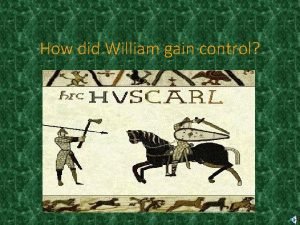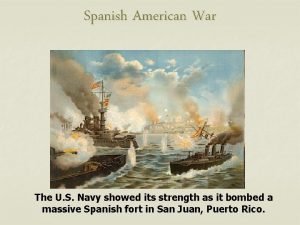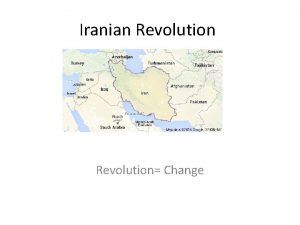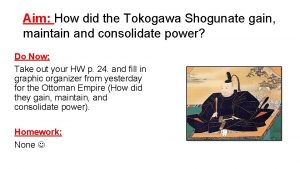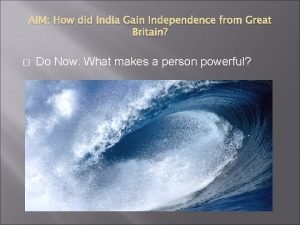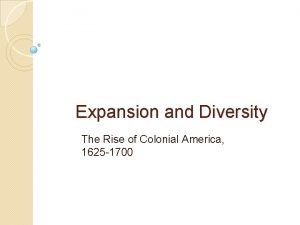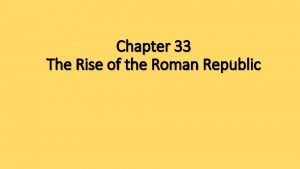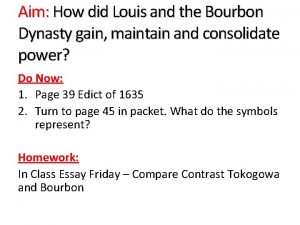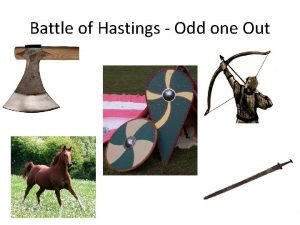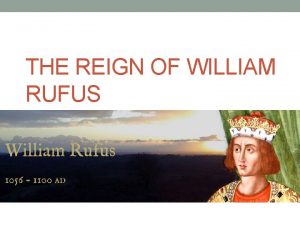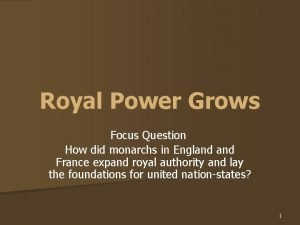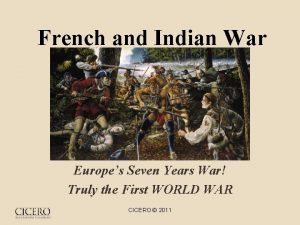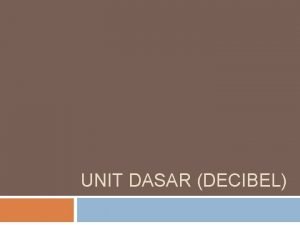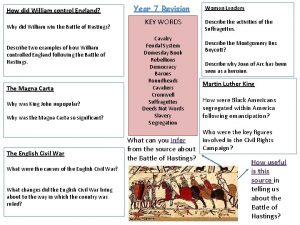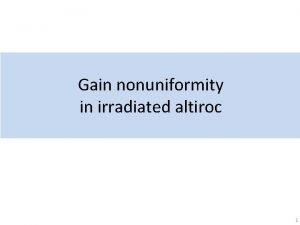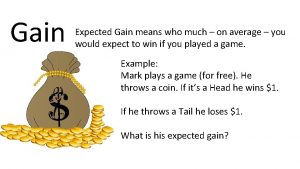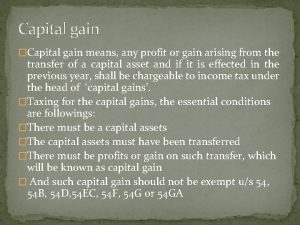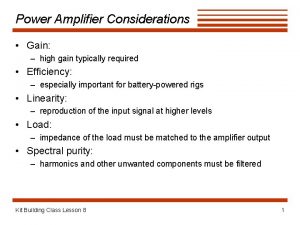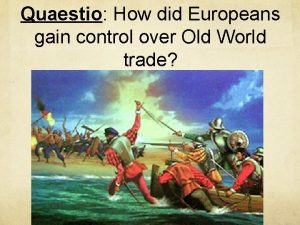How did William gain control How did William


































- Slides: 34

How did William gain control?

How did William take control of England following the Battle of Hastings? Stage 1: Subdue - Fear and Violence Stage 2: Impose authority - Castles Stage 3: Reward: The Feudal System Stage 4: Control: The Domesday Book

Even though William was crowned King on Christmas Day 1066, he did not fully conquer England until 1071. So what happened after the battle?

Stage 1 - Control • At the start of 1066 William was an invader. He had invaded England killed their King. • The people of England did not want William to be king so they were unwilling to obey him. • Many important nobles were prepared to rebel to try and get rid of William. • William firstly had to use fear and violence to SUBDUE the rebels and to scare the people.

Firstly, he returned to Hastings and waited for the English to surrender to him. When they did not come William asked for more soldiers to be sent from Normandy

After more soldiers arrived William gained control of the coast as far as Dover. This was important for two reasons: Firstly, Dover castle would have held English troops. Secondly, it was important to keep the route between Normandy and England in William’s control.

He then marched toward London. Although not the capital in those days, it was the centre of trade and communications. William knew that if he could gain control of London, he would control the land as far as the Humber.

River Humber Hastings

• First came the FEAR & VIOLENCE When the nobles in London did not surrender immediately, William destroyed property and murdered many people in the counties surrounding London.

This tactic worked…. Winchester (which was then the capital) surrendered. William was crowned king. William began building castles to protect his barons and help them keep control of the surrounding area. In 1067 William returned home to Normandy for a short time.

REBELLION AGAINST NORMAN RULE 1067 -71 Edgar the Aetheling Active in north 1069/70 Harrying of the North– Upwards of 150, 000 killed DEC-FEB 1069/70 KEY William’s movements Durham – Normans massacred by Gospatric JAN 1069 4. 5. Chester. William defeats Edric MAY? 1070 3. 2. Rebel movements Centre of rebellion Area depopulated by Harrying of North 6. Edric the Wild 1068 -70 Danish Fleet– operates in north 1069, overwinters in Humber York – estuary Normans 1069/71, massacred by Portion Gospatric, moves to Ely Edgar & 1070 before Vikings OCT negotiated 1069 withdrawal Hereward escapes? 1071 Stafford – William defeats Edric SEPT? 1069 Ely: Hereward the Wake, Swein and Morcar 107071 1. Area of Edric’s rebellion Exeter – defies William in JAN 1067, besieged by English 1069 Siege of Montacute 1069 LONDON Dover Eustace of Boulogne attacks NOV 1067

Did this mean England was now peacefully under Norman control? When the north rose in rebellion between 1069 -70 William and his men destroyed, burnt and murdered in a sweep across the country between York and Durham. Also in East Anglia an English rebel, Hereward the Wake, stirred up trouble against the Norman conquerors until he was subdued (or bought off).

Durham York

Stage 2: Keep people under your watch! • Once William had gained control of the rebels and the lands around London and south of the Humber he needed to begin to develop a way of running the country. • He couldn’t always go around fighting and killing rebels. • He used an extensive programme of castle building to keep a watch on the people of England.

The Motte and Bailey Castles One of the ways William kept control of England was to build castles everywhere near major routes. The reason for this was: To protect the Normans from attack. Protect routes so that troops could be moved around quickly and easily. To be a visual reminder to the English who was in control.

CASTLE SEQUENCES DURHAM YORK After 1080 CHESTER STAFFORD NORWICH 1070 -80 1068 -70 CAMBRIDGE 1067 -8 EXETER MONTACUTE EYE

Why build Motte and Bailey Castles? They were made of wood – so there was plenty of materials around to make them. They were fast to put up and only took under two weeks to build. They were enclosed and built on a mound of earth about 12 metres high, were well guarded and difficult to attack.

Keep Moat Motte Bailey Drawbridge


Why might motte and bailey castles be a bad idea? Because they are made from wood and can be burned down. Also being made from wood they can rot. Starting with the ‘keep’ they began to make castles from stone within a few years.

Stage 3: Normanization and reward • William could not keep fighting the English – he needed to have a country in peace and people who obeyed. • He began to reward those who were faithful and obedient and to punish those who were not. • He changed the land ownership of the country to give him land to reward people. • He also replaced the English barons with Norman barons who were loyal to him.

William and the feudal system William had two problems to deal with: 1) How to reward the people who had supported his invasion and keep them loyal to him. 2) Ensuring he could control the country. He knew he could not do it on his own – he needed to have the support of the barons. William granted the barons land. The barons had to make sure William had knights for his army.

After making a survey of England (the Domesday Book) – then came the Feudal System Many of the English Earls died in the battle of 1066 or the rebellions afterward (or fled abroad). William took their lands along with most of those who remained. He needed landowners he could depend upon. He therefore granted much of this land, as a reward, to those Normans that had fought with him.

Why did it work? Because William made sure the barons remained loyal by giving them grants of land. The knights remained loyal because the barons granted them land. The peasants didn’t have much choice, but did have grants of land protection.

The Feudal System • The most powerful person in the kingdom was the king. • He could order people to do whatever he liked. • He also owned all of the land. • He gave out land to his most important followers (Lords, Barons, Bishops) and in return they promised to protect him. • These people were called nobles. • The nobles would then give some land to their own followers, called Knights. • The Knights would then give some land to the Villeins (peasants) to farm for them. • The arrangement of giving land in return for loyalty or service was known as the feudal system. • Key fact - There were three classes of society in the Middle Ages. People either fought, prayed or worked for a living.


Key Questions • What percentage of the population do you think were • (a) Barons; • (b) Knights; • (c) Villeins?

Answers (rounded up) • Barons – almost 1% • Knights – about 4% • Villeins – about 95%

The barons and the feudal system The barons received land from William. In some cases the amount of land was huge! These estates were given in return for their support and service. One of their jobs was to supply knights to William's army. To deal with this job, and to handle their huge estates, the barons gave some of their land to the knights. In return, the knights' promised to serve in William’s army for 40 days each year.

The knights and the feudal system The knights received land from the barons in return for their promise to serve in William’s army for 40 days a year. The knights were professional soldiers who had trained for a long time in the art of medieval war. However, they were not farmers. To help them look after the land they shared the land out amongst peasant villagers who worked the fields.

The peasants and the feudal system The peasants gained little from the feudal system. They worked on the land paid taxes. But the system hadn't been much better for them before the Normans came along!

The Domesday Book King William decided that one of the best ways to keep control of England was to find out what people owned and make them pay taxes. In 1086 William sent his knights to every single village in the country to do a survey. He told the knights to find out what each person owned and to threaten to kill people if they would not tell them. The people were so scared that they thought it was their ‘doomsday. ’ William asked the knights to record everything they found out in a huge book. This became known as the Domesday Book.


How does the feudal system work? Promise to provide Gave grants of land to William Barons knights for the army 40 days per year Promise to serve in the army 40 days per year Knights Gave grants of land to Peasants Promise services and payments to the knights
 How did william the conqueror control england
How did william the conqueror control england Spanish
Spanish Sparta peninsula
Sparta peninsula Savak iran
Savak iran How did the tokugawa shogunate consolidate power in japan
How did the tokugawa shogunate consolidate power in japan How did india gain independence from great britain
How did india gain independence from great britain How did stalin gain and maintain power in the ussr?
How did stalin gain and maintain power in the ussr? Why did new netherland gain a reputation for diversity
Why did new netherland gain a reputation for diversity Plebeians characteristics
Plebeians characteristics How did louis xiv gain consolidate and maintain power
How did louis xiv gain consolidate and maintain power Glasser's basic needs
Glasser's basic needs William glasser control theory
William glasser control theory Translational research institute on pain in later life
Translational research institute on pain in later life Product inspection vs process control
Product inspection vs process control Fluids mechanics
Fluids mechanics Stock control e flow control
Stock control e flow control Control volume vs control surface
Control volume vs control surface Lac operon positive control
Lac operon positive control Negative control
Negative control Data link control
Data link control Control de flujo y control de errores
Control de flujo y control de errores Negative control vs positive control examples
Negative control vs positive control examples Error control and flow control
Error control and flow control Scalar control vs vector control
Scalar control vs vector control Control c control v
Control c control v Why william won the battle of hastings essay
Why william won the battle of hastings essay Why did william win the battle of hastings?
Why did william win the battle of hastings? How did william rufus die
How did william rufus die When was shakespeare born
When was shakespeare born Why did william win the battle of hastings
Why did william win the battle of hastings What did george calvert and william penn have in common
What did george calvert and william penn have in common How did william and henry ii increase royal power?
How did william and henry ii increase royal power? Did william pitt open the ohio river valley
Did william pitt open the ohio river valley Cleft palate weight gain
Cleft palate weight gain Satuan gain
Satuan gain
